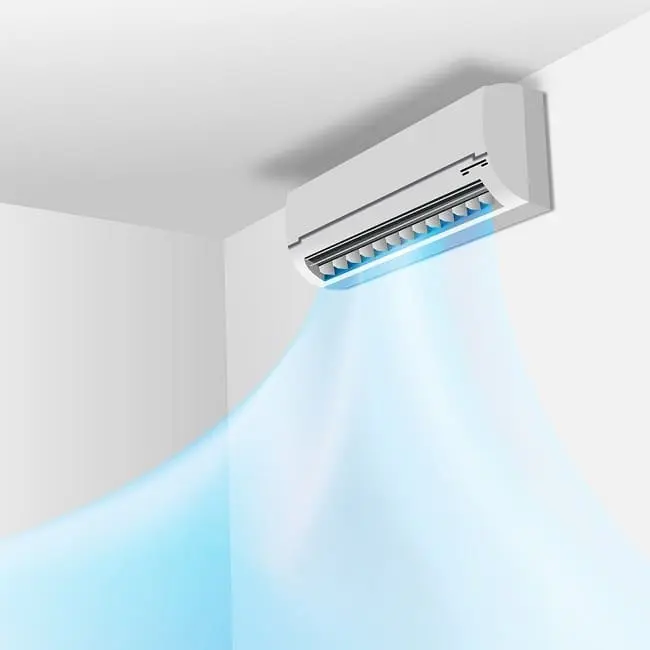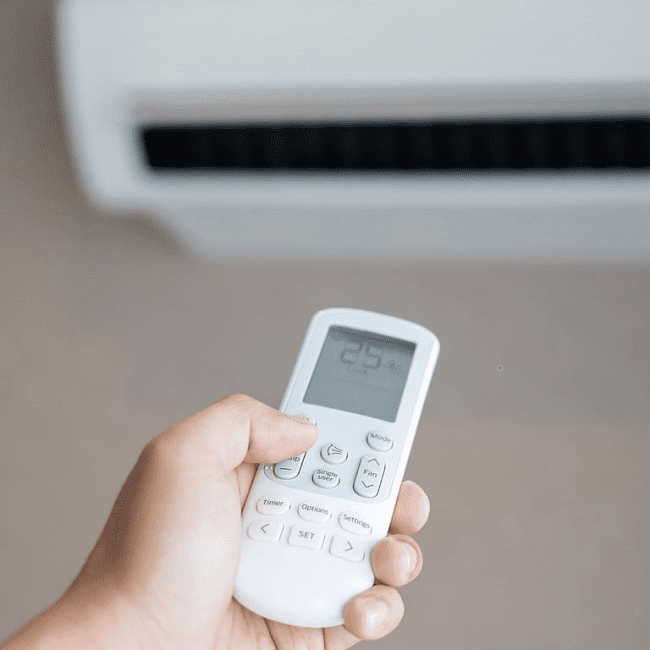Content
Air conditioning plays a central role in maintaining ideal temperature and humidity conditions in indoor spaces, ensuring the comfort of users and the preservation of property. It is used in a wide range of fields, including the residential, commercial, industrial and medical sectors. But how does air conditioning work?
What are the different air conditioner models available, and how do you make the right choice? How can you improve the efficiency and performance of your air conditioning system? We’ll answer these questions in this article.
First, we’ll look at the fundamental principles of air conditioner operation, based on the refrigeration cycle and heat exchange between two fluids. Next, we’ll explore the most common types of air conditioner: monoblocs, monosplits, multisplits and ductables. We’ll also guide you through the essential criteria for choosing the air conditioner best suited to your needs, taking into account power, noise, energy class and cost.
Finally, we’ll give you practical advice on how to improve the efficiency and performance of your air conditioning system, focusing on reducing energy consumption, enhancing thermal comfort and improving indoor air quality. In particular, we’ll discuss the benefits of reversible air conditioning, inverter technology, heat pumps and wifi options.

How air conditioning works?
Air conditioning operates on a thermodynamic cycle that uses a refrigerant to transfer heat from one environment to another. The fluid changes from a liquid to a gaseous state, depending on the temperature and pressure applied.
This cooling cycle comprises four basic phases: compression, condensation, expansion and evaporation.
How does the refrigeration cycle work?
The cooling process, or refrigeration cycle, produces cold by treating the refrigerant in the following way:
At the start of the cycle, the refrigerant, in the form of low-pressure cold vapor, is drawn into the compressor. Its pressure and temperature rise, transforming it into hot steam at high pressure.
Entering the condenser, a heat exchanger, the hot refrigerant vapour transfers its heat to a cooler fluid (air or water), cools and liquefies.
As it passes through the expansion valve, the fluid, now a liquid under high pressure, is reduced in pressure, lowering its temperature.
Finally, the low-pressure liquid refrigerant enters the evaporator. This heat exchanger enables it to absorb heat from a warmer medium (air or water), thereby heating and vaporizing it.
This process repeats itself continuously as long as the compressor is running, with the refrigerant circulating in a closed system without being consumed.
What are the components of an air conditioner?
An air-conditioning system, which adjusts the temperature and humidity conditions of an indoor space, is based on four key elements:
- The compressor, the engine of the refrigeration cycle, compresses the refrigerant and circulates it through the system;
- The condenser, the system’s first heat exchanger, cools and liquefies the refrigerant, releasing its heat. Depending on the air conditioner model, it may be installed inside or outside the building;
- The expansion valve, which adjusts the pressure of the refrigerant, lowering its temperature. It can be represented by a simple capillary tube, a thermostatic valve or an electronic valve;
- The evaporator, a second heat exchanger, which allows the refrigerant to evaporate and warm up by absorbing heat, and is located inside the air-conditioned room.
Heat transfer and refrigeration
Heat transfer, essential to the refrigerant’s change of state and the refrigeration cycle, can take place by conduction, convection or radiation, depending on the heat exchanger used. Refrigeration, the result of this transfer, consists in lowering the temperature of a medium by subtracting heat from it.
This process is necessary to cool indoor air, guarantee thermal comfort for occupants and preserve property.
What are the different types of air conditioner?
Different air conditioner models are designed to meet different needs. Ducted central air conditioners are ideal for larger homes, while splits (wall-mounted units) or portable air conditioners are perfect for smaller spaces or individual rooms. Advanced technologies such as inverters and solar energy optimize the energy efficiency and performance of air conditioners.
Let’s take a closer look at the specific features and mechanisms of each type of air conditioner.
Central air conditioners
Central air conditioners, designed to cool an entire dwelling via a network of ducts, consist of an outdoor unit (compressor, condenser, expansion valve) and an indoor unit (evaporator, fan).
These systems, which are often reversible, can also provide heat in winter. Although efficient, they are costly to purchase and install, and require regular maintenance and sufficient space for ductwork.
Monosplit and multisplit air conditioners
Split and multi-split systems, comprising one or more indoor units connected to an outdoor unit, can be wall-mounted, floor-mounted or recessed.
These systems feature an air filter, evaporator and fan, while the outdoor unit houses the compressor, condenser and expansion valve.
Main advantages: they are reversible, low-noise, more affordable and simpler to install than central air conditioners, although they do require walls to be pierced for pipes to pass through.
Portable air conditioners
Portable and window air conditioners are monobloc systems that concentrate all the components required for the refrigeration cycle in a single unit.
Easy to move thanks to their castors, portable models connect to a window or air outlet to discharge hot air. Fixed window air conditioners are installed in the frame of a window or wall and discharge the warm air outside.
Although they are economical and suitable for occasional use or small spaces, their efficiency and noise levels often leave much to be desired.
Sustainable air conditioning: 3 technological innovations
Technological innovation aims to improve the efficiency, consumption and comfort of air conditioners. These advances include :
Inverter, which adjusts compressor speed according to need, minimizing temperature fluctuations, noise and energy consumption.
Solar, which uses renewable energy to power the compressor or fan, reducing energy costs and environmental impact.
Wifi, enabling remote control of the air conditioner via an app or remote control, facilitating programming, temperature setting and choice of operating mode.
Although these technologies increase the initial cost and complexity of systems, they are available on most air conditioners.

How to operate an air conditioner properly?
To maximize the benefits of air conditioning, it’s essential to ensure its efficiency and performance. This means choosing the right equipment, regular maintenance and judicious use.
Adopting these practices reduces energy consumption, increases system longevity and guarantees optimum thermal comfort.
Here are a few recommendations for improving the efficiency and performance of your air conditioning system.
Heat load calculation and sizing
Thermal load is the amount of heat required to keep a room cool. It varies according to the size of the room, its orientation, insulation, the number of people in it, and internal and external heat sources.
The aim of the sizing calculation is to determine the air conditioner capacity required for this heat load. This calculation is essential for choosing an air conditioner that exactly matches your needs.
An undersized or oversized unit can lead to excessive energy consumption, insufficient thermal comfort, accelerated system wear or humidity problems.
Air conditioning: maintenance and care
Regular maintenance is essential to keep your air conditioning system running smoothly and at peak efficiency. We recommend frequent cleaning of air filters, air ducts, indoor and outdoor units.
It’s also important to check circuit tightness, refrigerant levels and the condition of electrical components. We strongly recommend that you call in a qualified professional for an annual check-up and any necessary repairs.
How to use air conditioning to save energy?
For optimum air-conditioning performance, we recommend keeping the temperature between 24 and 26°C in summer and between 19 and 21°C in winter. Avoid leaving the unit running all the time, and program it according to your actual needs.
Keep doors and windows closed when the appliance is on, and use curtains or blinds to block the sun’s heat. Opt for low-energy appliances equipped with an inverter or solar technology for greater efficiency.
Benefits of thermal insulation and air conditioning
Good insulation and appropriate glazing play a major role in improving the performance of air-conditioning systems. They help reduce heat loss in winter and heat gain in summer, thus lowering the system’s thermal load and energy consumption.
It’s important to choose the right insulation and glazing for your home, taking into account the type of material, thickness and thermal resistance coefficient. Choose double or triple glazing for better sound and heat insulation.
This article has guided you through how air conditioning works, explored the different models available and given you tips on choosing the ideal unit.
You’ve also discovered tips for improving the efficiency and performance of your air conditioning system, allowing you to maximize your comfort while minimizing your energy consumption and impact on the environment.
For the installation or replacement of your air conditioner, we recommend that you call on a qualified professional who can offer you personalized advice and a no-obligation quote.
